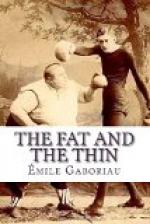These remarks, I trust, will not be considered out of place in an introduction to a work which to no small extent treats of the appetite of Paris. The reader will find that the characters portrayed by M. Zola are all types of humble life, but I fail to see that their circumstances should render them any the less interesting. A faithful portrait of a shopkeeper, a workman, or a workgirl is artistically of far more value than all the imaginary sketches of impossible dukes and good and wicked baronets in which so many English novels abound. Several of M. Zola’s personages seem to me extremely lifelike—Gavard, indeed, is a chef-d’oeuvre of portraiture: I have known many men like him; and no one who lived in Paris under the Empire can deny the accuracy with which the author has delineated his hero Florent, the dreamy and hapless revolutionary caught in the toils of others. In those days, too, there was many such a plot as M. Zola describes, instigated by agents like Logre and Lebigre, and allowed to mature till the eve of an election or some other important event which rendered its exposure desirable for the purpose of influencing public opinion. In fact, in all that relates to the so-called “conspiracy of the markets,” M. Zola, whilst changing time and place to suit the requirements of his story, has simply followed historical lines. As for the Quenus, who play such prominent parts in the narrative, the husband is a weakling with no soul above his stewpans, whilst his wife, the beautiful Lisa, in reality wears the breeches and rules the roast. The manner in which she cures Quenu of his political proclivities, though savouring of persuasiveness rather than violence, is worthy of the immortal Mrs. Caudle: Douglas Jerrold might have signed a certain lecture which she administers to her astounded helpmate. Of Pauline, the Quenus’ daughter, we see but little in the story, but she becomes the heroine of another of M. Zola’s novels, “La Joie de Vivre,” and instead of inheriting the egotism of her parents, develops a passionate love and devotion for others. In a like way Claude Lantier, Florent’s artist friend and son of Gervaise of the “Assommoir,” figures more particularly in “L’Oeuvre,” which tells how his painful struggle for fame resulted in madness and suicide. With reference to the beautiful Norman and the other fishwives and gossips scattered through the present volume, and those genuine types of Parisian gaminerie, Muche, Marjolin, and Cadine, I may mention that I have frequently chastened their language in deference to English susceptibilities, so that the story, whilst retaining every essential feature, contains nothing to which exception can reasonably be taken.
E. A. V.




